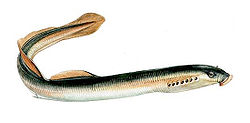Description
The chestnut lamprey has a maximum length of around 38 centimetres (15 in), [5] with a tan to yellowish-olive hue above, the sides, belly, and fin lighter. [5] They are blue-black just after spawning. [6] The jawless mouth expands wider than the head, with many firm slender teeth, typically 4 lateral bicuspids on both sides of the innermost row, in front of which are 6–11 sharp cusps, and 2–3 anterior to the mouth. [5] It has a long dorsal fin and no paired fins. [5]
Life cycle
During the egg stage of the lamprey's life, it is vulnerable to predators that prefer to eat fish eggs. [6] Predation by other fish helps keep lamprey numbers under control. When the lamprey has hatched from its egg into the larvae stage, it is limited to pools or backwater areas with a sand or sandy mud bottom. [7] The young lampreys filter feed for food for around five to seven years until they are large enough to attach themselves to a host species. [6] Spawning of this species of lamprey occurs from June to July when the animals are around seven to nine years old and migrate to tributaries to protect the young from predators, though most spawning activity has been observed in mid-June. [6] During the mating process, one female would begin moving rocks from a suitable area for eggs; afterward she attaches herself to a rock while hopeful males attach to her and stroke her tail attempting to mate. [8] The eggs are then covered with a rock, presumably to shade the young lampreys at birth and to keep any predators from devouring the young. [8] As with most lampreys, the chestnut lamprey only mates once during its entire life and dies shortly after. [6]
This page is based on this
Wikipedia article Text is available under the
CC BY-SA 4.0 license; additional terms may apply.
Images, videos and audio are available under their respective licenses.





